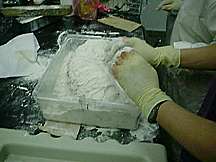

Both the hepta- and the decahydrate effloresce (lose water) in dry air and are partially transformed into the monohydrate thermonatrite Na 2CO 3

The term hydrated sodium carbonate is commonly used to encompass the monohydrate (Na 2CO 3 It crystallizes in the monoclinic-domatic crystal system, typically forming efflorescences and encrustations.

Sodium carbonate decahydrate has a specific gravity of 1.42 to 1.47 and a Mohs hardness of 1. Natron is also the mineralogical name for the compound sodium carbonate decahydrate (Na 2CO 3 ♱0H 2O), which is the main component in historical natron. Some of its ancient household roles are also now filled by ordinary baking soda, natron's other meaningful ingredient.Ĭhemistry of hydrated sodium carbonate Soda ash also replaced natron in glass-making. Natron's detergent properties are now commercially supplied by soda ash, the mixture's chief compound ingredient, along with other chemicals. Most of natron's uses both in the home and by industry were gradually replaced with closely related sodium compounds and minerals. The mineral was also employed as a flux to solder precious metals together. It was used along with sand and lime in ceramic and glass-making by the Romans and others at least until 640 AD. Natron is an ingredient for making a distinct color called Egyptian blue. Natron was added to castor oil to make a smokeless fuel, which allowed Egyptian artisans to paint elaborate artworks inside ancient tombs without staining them with soot. In some cultures natron was thought to enhance spiritual safety for both the living and the dead. Moreover, when exposed to moisture the carbonate in natron increases pH (raises alkalinity), which creates a hostile environment for bacteria. The mineral was used in Egyptian mummification because it absorbs water and behaves as a drying agent. It was also an ancient household insecticide, was used for making leather and as a bleach for clothing. Natron can be used to dry and preserve fish and meat. The mineral was mixed into early antiseptics for wounds and minor cuts. Undiluted, natron was a cleanser for the teeth and an early mouthwash. It softens water while removing oil and grease. Blended with oil, it was an early form of soap.

Historical natron was harvested directly as a salt mixture from dry lake beds in Ancient Egypt and has been used for thousands of years as a cleaning product for both the home and body. The modern chemical symbol for sodium, Na, is an abbreviation of that element's New Latin name natrium, which was derived from natron. The English word natron is a French cognate derived from the Spanish natrón through Greek νιτρων nitron, which derived from the Ancient Egyptian word netjeri, meaning natron.


 0 kommentar(er)
0 kommentar(er)
